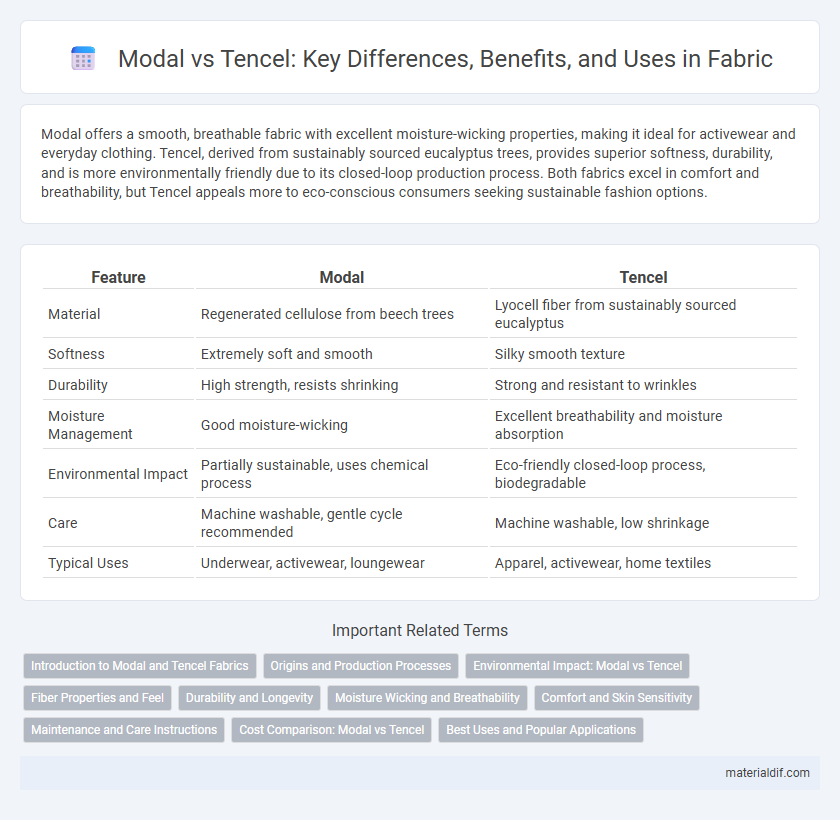Modal offers a smooth, breathable fabric with excellent moisture-wicking properties, making it ideal for activewear and everyday clothing. Tencel, derived from sustainably sourced eucalyptus trees, provides superior softness, durability, and is more environmentally friendly due to its closed-loop production process. Both fabrics excel in comfort and breathability, but Tencel appeals more to eco-conscious consumers seeking sustainable fashion options.
Table of Comparison
| Feature | Modal | Tencel |
|---|---|---|
| Material | Regenerated cellulose from beech trees | Lyocell fiber from sustainably sourced eucalyptus |
| Softness | Extremely soft and smooth | Silky smooth texture |
| Durability | High strength, resists shrinking | Strong and resistant to wrinkles |
| Moisture Management | Good moisture-wicking | Excellent breathability and moisture absorption |
| Environmental Impact | Partially sustainable, uses chemical process | Eco-friendly closed-loop process, biodegradable |
| Care | Machine washable, gentle cycle recommended | Machine washable, low shrinkage |
| Typical Uses | Underwear, activewear, loungewear | Apparel, activewear, home textiles |
Introduction to Modal and Tencel Fabrics
Modal fabric, made from beech tree cellulose, is known for its smooth texture, breathability, and resistance to shrinkage, making it ideal for soft, comfortable clothing. Tencel, a brand of lyocell fiber derived from sustainably sourced eucalyptus trees, offers excellent moisture management, durability, and eco-friendly production processes. Both fabrics serve as versatile alternatives to cotton, prized for their softness and environmental benefits in textile manufacturing.
Origins and Production Processes
Modal fabric originates from beech tree pulp, processed through a chemically intensive method that transforms cellulose into soft, breathable fibers known for their durability. Tencel, branded lyocell, is derived from sustainably sourced eucalyptus trees and produced via an eco-friendly closed-loop process that recycles water and solvents, minimizing environmental impact. Both fabrics utilize wood-based cellulose but differ significantly in their production techniques, impacting sustainability and fabric performance.
Environmental Impact: Modal vs Tencel
Modal fabric is derived from beech trees using a chemical process that requires significant water and energy consumption, contributing to moderate environmental impact. Tencel, made from sustainably sourced eucalyptus wood through a closed-loop production system, minimizes water usage and recycles solvents, resulting in a significantly lower ecological footprint. Both fabrics offer biodegradable options, but Tencel's production process is widely recognized for superior sustainability and reduced environmental harm.
Fiber Properties and Feel
Modal fibers, derived from beech tree pulp, are known for their exceptional softness, high moisture absorption, and resistance to shrinkage, resulting in a smooth, silky feel that drapes well on the body. Tencel, made from sustainably sourced eucalyptus wood pulp, offers a slightly firmer texture with superior breathability, moisture-wicking capabilities, and natural antibacterial properties, making it ideal for activewear and sensitive skin. Both fibers excel in eco-friendly production, but Modal provides a luxurious, silky hand while Tencel delivers durability combined with a cool, smooth touch.
Durability and Longevity
Modal fabric, made from beech tree pulp, offers excellent durability and resists pilling and shrinking, making it a long-lasting choice for everyday wear. Tencel, derived from eucalyptus fibers, combines strength and flexibility, providing superior tear resistance and moisture-wicking properties that enhance fabric longevity. Both fabrics excel in durability, but Tencel's eco-friendly production process and enhanced fiber resilience often give it an edge in maintaining fabric quality over time.
Moisture Wicking and Breathability
Modal fabric offers excellent moisture-wicking properties by efficiently drawing sweat away from the skin, enhancing comfort during physical activities. Tencel, derived from eucalyptus fibers, excels in breathability due to its smooth fiber surface, allowing superior air circulation and rapid moisture evaporation. Both fabrics provide natural moisture management, but Tencel's eco-friendly production and enhanced airflow make it a preferred choice for breathable and moisture-wicking textiles.
Comfort and Skin Sensitivity
Modal fabric offers exceptional softness and breathability, making it highly comfortable for daily wear and ideal for sensitive skin due to its hypoallergenic properties. Tencel, derived from sustainable eucalyptus trees, provides superior moisture-wicking and temperature regulation, enhancing comfort while minimizing irritation for sensitive skin types. Both fabrics excel in durability and softness, but Tencel's eco-friendly production adds an advantage for environmentally conscious consumers seeking comfort and skin-friendly materials.
Maintenance and Care Instructions
Modal fabric requires gentle machine washing in cold water with mild detergent and should be air-dried or tumble dried on low heat to prevent shrinkage and maintain softness. Tencel, made from sustainably sourced wood pulp, demands hand washing or machine washing on a delicate cycle with eco-friendly detergent and benefits from air drying to preserve its natural luster and strength. Both fabrics avoid bleach and high heat, with Tencel generally showing higher resistance to wrinkles and better biodegradability during maintenance.
Cost Comparison: Modal vs Tencel
Modal fabric typically costs less than Tencel due to its more established manufacturing processes and higher availability, making it a budget-friendly option for clothing and linens. Tencel, derived from sustainably sourced eucalyptus, commands a higher price point reflecting its eco-friendly production and superior moisture-wicking properties. Buyers aiming for affordability often prefer Modal, while those prioritizing sustainable luxury tend to invest in Tencel despite its premium cost.
Best Uses and Popular Applications
Modal fabric excels in softness and moisture-wicking properties, making it ideal for activewear, underwear, and loungewear that require breathability and comfort. Tencel, derived from sustainably sourced eucalyptus, offers superior strength, wrinkle resistance, and a smooth, silky texture, preferred in high-end apparel, bedding, and eco-friendly fashion collections. Both fibers are biodegradable and sustainable, but Modal is better suited for garments demanding stretch and softness, while Tencel is favored for durable, luxurious textiles with moisture management.
Modal vs Tencel Infographic

 materialdif.com
materialdif.com